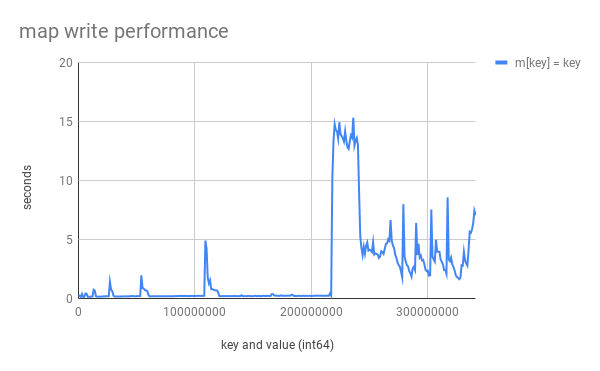1
2
3
4
5
6
7
8
9
10
11
12
13
14
15
16
17
18
19
20
21
22
23
24
25
26
27
28
29
30
31
32
33
34
35
36
37
38
39
40
41
42
43
44
45
46
47
48
49
50
| TEXT main.write(SB) /Users/changkun/dev/go-under-the-hood/demo/7-lang/map/main.go
(...)
main.go:10 0x109386a 0f118c2450010000 MOVUPS X1, 0x150(SP)
main.go:11 0x1093872 0f57c9 XORPS X1, X1
main.go:11 0x1093875 0f118c2498010000 MOVUPS X1, 0x198(SP)
main.go:11 0x109387d 0f57c9 XORPS X1, X1
main.go:11 0x1093880 0f118c24a8010000 MOVUPS X1, 0x1a8(SP)
main.go:11 0x1093888 0f57c9 XORPS X1, X1
main.go:11 0x109388b 0f118c24b8010000 MOVUPS X1, 0x1b8(SP)
main.go:11 0x1093893 488d7c2478 LEAQ 0x78(SP), DI
main.go:11 0x1093898 0f57c0 XORPS X0, X0
main.go:11 0x109389b 488d7fd0 LEAQ -0x30(DI), DI
main.go:11 0x109389f 48896c24f0 MOVQ BP, -0x10(SP)
main.go:11 0x10938a4 488d6c24f0 LEAQ -0x10(SP), BP
main.go:11 0x10938a9 e824dffbff CALL 0x10517d2
main.go:11 0x10938ae 488b6d00 MOVQ 0(BP), BP
main.go:11 0x10938b2 488d842498010000 LEAQ 0x198(SP), AX
main.go:11 0x10938ba 8400 TESTB AL, 0(AX)
main.go:11 0x10938bc 488d442478 LEAQ 0x78(SP), AX
main.go:11 0x10938c1 48898424a8010000 MOVQ AX, 0x1a8(SP)
main.go:11 0x10938c9 488d842498010000 LEAQ 0x198(SP), AX
main.go:11 0x10938d1 4889842420010000 MOVQ AX, 0x120(SP)
main.go:11 0x10938d9 e8e2c3faff CALL runtime.fastrand(SB)
main.go:11 0x10938de 488b842420010000 MOVQ 0x120(SP), AX
main.go:11 0x10938e6 8400 TESTB AL, 0(AX)
main.go:11 0x10938e8 8b0c24 MOVL 0(SP), CX
main.go:11 0x10938eb 89480c MOVL CX, 0xc(AX)
main.go:11 0x10938ee 488d842498010000 LEAQ 0x198(SP), AX
main.go:11 0x10938f6 4889842408010000 MOVQ AX, 0x108(SP)
main.go:12 0x10938fe 48c744245000000000 MOVQ $0x0, 0x50(SP)
(...)
main.go:14 0x109394d eb63 JMP 0x10939b2
main.go:15 0x109394f 488b442450 MOVQ 0x50(SP), AX
main.go:15 0x1093954 4803442448 ADDQ 0x48(SP), AX
main.go:15 0x1093959 4889442470 MOVQ AX, 0x70(SP)
main.go:15 0x109395e 488d05fb6d0100 LEAQ runtime.rodata+92544(SB), AX
main.go:15 0x1093965 48890424 MOVQ AX, 0(SP)
main.go:15 0x1093969 488b8c2408010000 MOVQ 0x108(SP), CX
main.go:15 0x1093971 48894c2408 MOVQ CX, 0x8(SP)
main.go:15 0x1093976 488b4c2450 MOVQ 0x50(SP), CX
main.go:15 0x109397b 48034c2448 ADDQ 0x48(SP), CX
main.go:15 0x1093980 48894c2410 MOVQ CX, 0x10(SP)
main.go:15 0x1093985 e846b0f7ff CALL runtime.mapassign_fast64(SB)
main.go:15 0x109398a 488b442418 MOVQ 0x18(SP), AX
main.go:15 0x109398f 4889842418010000 MOVQ AX, 0x118(SP)
main.go:15 0x1093997 8400 TESTB AL, 0(AX)
main.go:15 0x1093999 488b4c2470 MOVQ 0x70(SP), CX
main.go:15 0x109399e 488908 MOVQ CX, 0(AX)
main.go:15 0x10939a1 eb00 JMP 0x10939a3
(...)
|
 图1: cgo/Go/C/net 包 在网络 I/O 场景下的性能对比,图取自 github.com/changkun/cgo-benchmarks
图1: cgo/Go/C/net 包 在网络 I/O 场景下的性能对比,图取自 github.com/changkun/cgo-benchmarks